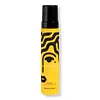What's inside
What's inside
 Key Ingredients
Key Ingredients

No key ingredients
 Benefits
Benefits

 Concerns
Concerns

 Ingredients Side-by-side
Ingredients Side-by-side

Aloe Barbadensis Leaf Juice Powder
Skin ConditioningWater
Skin ConditioningPolyquaternium-55
Cocamidopropyl Betaine
CleansingHeptyl Glucoside
Hydroxypropyltrimonium Hydrolyzed Corn Starch
Hydrolyzed Adansonia Digitata Seed Extract
Caprylhydroxamic Acid
Caprylyl Glycol
EmollientGlycerin
HumectantSodium Phytate
Citric Acid
BufferingAnthemis Nobilis Flower Oil
MaskingCananga Odorata Flower Oil
MaskingCanarium Commune Gum Oil
MaskingCaprylic/Capric Triglyceride
MaskingCitrus Aurantium Dulcis Flower Oil
AstringentGeranium Maculatum Oil
MaskingJasminum Officinale Flower/Leaf Extract
MaskingJuniperus Virginiana Oil
MaskingLitsea Cubeba Fruit Oil
MaskingRosa Damascena Extract
MaskingRosa Damascena Flower Oil
MaskingTanacetum Annuum Flower/Leaf/Stem Oil
MaskingTocopheryl Acetate
AntioxidantAloe Barbadensis Leaf Juice Powder, Water, Polyquaternium-55, Cocamidopropyl Betaine, Heptyl Glucoside, Hydroxypropyltrimonium Hydrolyzed Corn Starch, Hydrolyzed Adansonia Digitata Seed Extract, Caprylhydroxamic Acid, Caprylyl Glycol, Glycerin, Sodium Phytate, Citric Acid, Anthemis Nobilis Flower Oil, Cananga Odorata Flower Oil, Canarium Commune Gum Oil, Caprylic/Capric Triglyceride, Citrus Aurantium Dulcis Flower Oil, Geranium Maculatum Oil, Jasminum Officinale Flower/Leaf Extract, Juniperus Virginiana Oil, Litsea Cubeba Fruit Oil, Rosa Damascena Extract, Rosa Damascena Flower Oil, Tanacetum Annuum Flower/Leaf/Stem Oil, Tocopheryl Acetate
Water
Skin ConditioningPolyquaternium-11
Pvp
Emulsion StabilisingCocamidopropyl Betaine
CleansingAlthaea Officinalis Root Extract
Skin ConditioningGlycerin
HumectantRicinus Communis Seed Oil
MaskingArgania Spinosa Kernel Oil
EmollientCaprylic/Capric Triglyceride
MaskingBiotin
AntiseborrhoeicPolyglyceryl-4 Caprate
EmulsifyingPolyglyceryl-6 Caprylate
EmulsifyingSodium Chloride
MaskingC12-18 Acid Triglyceride
EmollientCocamidopropyl Dimethylamine
EmulsifyingSodium Glycolate
BufferingSodium Benzoate
MaskingBenzyl Alcohol
PerfumingEthylhexylglycerin
Skin ConditioningParfum
MaskingBenzyl Benzoate
AntimicrobialHexyl Cinnamal
PerfumingAmyl Cinnamal
PerfumingHydroxycitronellal
PerfumingLinalool
PerfumingCitronellol
PerfumingLimonene
PerfumingCoumarin
PerfumingGeraniol
PerfumingWater, Polyquaternium-11, Pvp, Cocamidopropyl Betaine, Althaea Officinalis Root Extract, Glycerin, Ricinus Communis Seed Oil, Argania Spinosa Kernel Oil, Caprylic/Capric Triglyceride, Biotin, Polyglyceryl-4 Caprate, Polyglyceryl-6 Caprylate, Sodium Chloride, C12-18 Acid Triglyceride, Cocamidopropyl Dimethylamine, Sodium Glycolate, Sodium Benzoate, Benzyl Alcohol, Ethylhexylglycerin, Parfum, Benzyl Benzoate, Hexyl Cinnamal, Amyl Cinnamal, Hydroxycitronellal, Linalool, Citronellol, Limonene, Coumarin, Geraniol
Alternatives
Ingredients Explained
These ingredients are found in both products.
Ingredients higher up in an ingredient list are typically present in a larger amount.
This ingredient is an emollient, solvent, and texture enhancer. It is considered a skin-softener by helping the skin prevent moisture loss.
It helps thicken a product's formula and makes it easier to spread by dissolving clumping compounds.
Caprylic Triglyceride is made by combining glycerin with coconut oil, forming a clear liquid.
While there is an assumption Caprylic Triglyceride can clog pores due to it being derived from coconut oil, there is no research supporting this.
Learn more about Caprylic/Capric TriglycerideCocamidopropyl Betaine is a fatty acid created by mixing similar compounds in coconut oil and dimethylaminopropylamine, a compound with two amino groups.
This ingredient is a surfactant and cleanser. It helps gather the dirt, pollutants, and other impurities in your skin to be washed away. It also helps thicken a product and make the texture more creamy.
Being created from coconut oil means Cocamidopropyl Betaine is hydrating for the skin.
While Cocamidopropyl Betaine was believed to be an allergen, a study from 2012 disproved this. It found two compounds in unpure Cocamidopropyl Betaine to be the irritants: aminoamide and 3-dimethylaminopropylamine. High-grade and pure Cocamidopropyl Betaine did not induce allergic reactions during this study.
Learn more about Cocamidopropyl BetaineGlycerin is already naturally found in your skin. It helps moisturize and protect your skin.
A study from 2016 found glycerin to be more effective as a humectant than AHAs and hyaluronic acid.
As a humectant, it helps the skin stay hydrated by pulling moisture to your skin. The low molecular weight of glycerin allows it to pull moisture into the deeper layers of your skin.
Hydrated skin improves your skin barrier; Your skin barrier helps protect against irritants and bacteria.
Glycerin has also been found to have antimicrobial and antiviral properties. Due to these properties, glycerin is often used in wound and burn treatments.
In cosmetics, glycerin is usually derived from plants such as soybean or palm. However, it can also be sourced from animals, such as tallow or animal fat.
This ingredient is organic, colorless, odorless, and non-toxic.
Glycerin is the name for this ingredient in American English. British English uses Glycerol/Glycerine.
Learn more about GlycerinWater. It's the most common cosmetic ingredient of all. You'll usually see it at the top of ingredient lists, meaning that it makes up the largest part of the product.
So why is it so popular? Water most often acts as a solvent - this means that it helps dissolve other ingredients into the formulation.
You'll also recognize water as that liquid we all need to stay alive. If you see this, drink a glass of water. Stay hydrated!
Learn more about Water